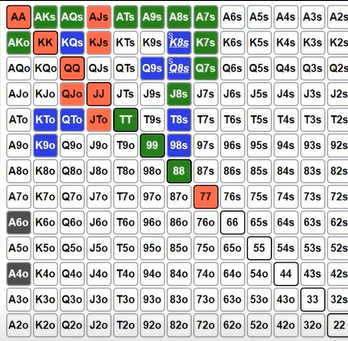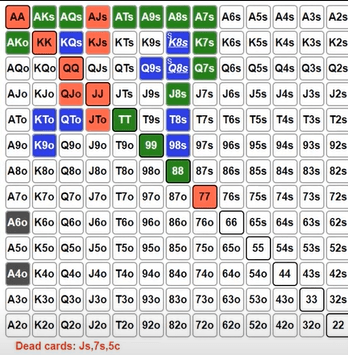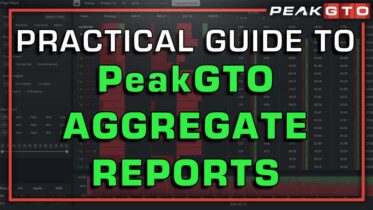A member asked me recently about what stack size adjustments they should make when the average stack size is 10-15 big blinds late in poker tournaments. If the majority of the table is playing with a prominently short stack size, what is the best way to adjust without simply moving all-in every time you are dealt a playable hand? Many novice poker players make the mistake of approaching short-stacked poker like a game of bingo, they will either shove or fold preflop with hopes of getting lucky and doubling up. Such a strategy is not profitable and makes you easy to play against. As with any decision you make at the poker table, the specific details of each hand should heavily influence what you do. If you are able to make the right short stack adjustments late in tournaments, you give yourself a proper chance to make the final table.
Questions To Ask Yourself When Playing Short Stacked
There are three critical components to consider when it comes to your short stacked decision-making. When playing short stacked, ask yourself the following three questions when contemplating a decision:
- Am I in or out of position?
- What is the board?
- What are the ranges of myself and my opponent?
When you are short stacked, you play your ranges, not your cards. Whatever position you are in and how the board flops greatly impacts what your range is. Consider how one flop is approached in four different ways based on a player’s position and preflop strategy.
Positional Adjustments To Make When Short Stacked
Out Of Position As The Preflop Caller
The majority of the time you will be playing post-flop out of position as a short stack is when you call a preflop raise from the blinds. When the flop comes, you should check almost every time looking to either check-raise all-in, check-call, or check-raise small. Execute check-raise shoves with strong made hands and draws when the board is coordinated. With strong made hands and draws on uncoordinated boards, check-call or check-raise small.
Hand Example: Short Stacked Out Of Position (PFC)

Chart Information: Green = Marginal Hand (Call), Blue = Draw (Raise),
Red = Premium Hand (Raise), Gray = Junk (Fold)
The cutoff min-raises and you call from the big blind with 15 big blinds effective. The flop comes J♠-7♠-5♣. Examining the above chart, you will see all of the cards that are in your range by the flop. All of the marked hands, regardless of color, should be in your flatting range preflop. It may be confusing to see hands like pocket queens and jacks unmarked, but they are not in your range as you would have moved all-in with them preflop.
You will notice that you are flatting preflop with an extremely wide range, containing the majority of possible hands you may be dealt. Although 8-2 suited may seem like a no-brainer fold, you only have to risk one additional blind to win 5.5 big blinds (your bet, your opponent’s bets, plus the blinds and antes). In this spot, you only have to realize 18% equity for the call to be profitable, and a hand like 8-2 suited lets you realize well above that.
Following a bet from your opponent, the above chart displays what your response should be depending on your hand. Hands marked in red/blue should be raised, hands in green should be called, and grey hands should be mucked. When classifying what your made hands are in this spot, include pairs as they are good enough to raise with, as are gutshot straight draws. The bet size of your check-raises is dependent on how much your opponent bet, if they only bet one big blind, you can raise 3-4 big blinds, but if they make a large bet you should just shove.
Notice that within your calling range, you are slowplaying your best premium hands preflop and continuing to do so within your post-flop strategy. Pocket aces and pocket kings should be slowplayed as you don’t mind letting your opponent bet into you when you have these hands. Although king-high is marked as a calling hand in the above chart, don’t be afraid to under-defend, especially if an overly tight opponent keeps betting.
Look to strengthen your check-calling range as well. Opponents will often continuation bet the flop, but then check down the turn and river. In these hands, just ace-high can be good enough to take it down.
In Position As The Preflop Caller
Playing the flop short-stacked as the preflop caller, the best strategy when facing a bet is to raise all-in with made hands and draws on coordinated boards. Just like when you are playing out of position, call or raise small (if your opponent bets small) with strong made hands and draws when the board is uncoordinated.
Your range will be especially strong following your preflop call, so consider trapping with the majority of your range by calling your opponent’s flop bets.
Hand Example: Short Stacked In Position (PFC)

Chart Information: Green = Marginal Hand (Call), Blue = Draw (Call),
Red = Premium Hand (Call), Gray = Junk (Fold)
The above chart represents the incredibly narrow flatting range you have facing a cutoff min-raise from the button with 15 big blinds effective. While the vast majority of players do not have a flatting range in this spot, by having one you give yourself an edge!
The flop comes J♠-7♠-5♣ and your opponent bets small. Examining the categorized hands in your range, you will see that regardless of how a hand is sorted you are calling with almost all of your range. By having such a strong range, you can call with hands like king-high that have runner-runner straight potential and can hit top-pair on the turn or river.
Usually when flops containing one big card come, it benefits your short stacked calling range. By having a fundamentally sound preflop calling strategy, when a board like J♠-7♠-5♣ comes it connects well with your range and gives you the advantage.
In Position As The Preflop Raiser
As the preflop aggressor with position, utilize larger bet sizes on coordinated flops, as you will lack the nut advantage more often on these boards. Playing the flop as the preflop raiser with position, bet about 50% of the pot with strong made hands and draws on coordinated boards. You will want to utilize a bigger bet size on coordinated boards, as coordinated boards give you less of a range advantage. If the board is uncoordinated, bet 30% pot with almost your entire range, as you still maintain a heavy range advantage.
Hand Example: Short Stacked In Position (PFR)

Chart Information: Green = Marginal Hand (Check), Blue = Draw (Bet),
Red = Premium Hand (Bet), Gray = Junk (Check)
Let’s revisit the same J♠-7♠-5♣ flop, but this time with position as the preflop raiser. You min-raised from the cutoff, and only the big blind called. The above chart represents an optimal preflop raising range, and how it should interact with this board. The range may look a bit peculiar, but that is because you are jamming hands like A-J offsuit and lower pocket pairs preflop.
Since you have the benefit of position, you can expand your small continuation betting range to include more draws and junkier hands that have some equity. While a GTO solver may suggest mixing more (like checking premium pairs like pocket aces and kings at some frequency), for the most part, this simplified strategy will be effective and easier to implement.
Given your range is so strong, you can even get away with betting everything in your range on this board, as long as it is for a small sizing.
Out Of Position As The Preflop Raiser
Now let’s consider playing short-stacked as the preflop raiser out of position. Much like previous positions, bet 50% pot with strong made hands and draws on coordinated boards, and opt to check-raise some portion of the time. On uncoordinated boards, bet 30% with almost your entire range while still opting to check-raise all-in some portion of the time.
Hand Example: Short Stacked Out Of Position (PFR)
Looking at the J♠-7♠-5♣ flop one last time, below is the optimal range with your playable hands.

Chart Information: Green = Marginal Hand (Check), Blue = Draw (Bet),
Red = Premium Hand (Bet), Gray = Junk (Check)
The range is not too far removed from your in-position preflop raising range. The biggest difference out of position is that you will have some more hands in your checking range (remember the strong calling range you had in position, your opponent has it now). Bet your premium-made hands, but mix in some checks to strengthen your check-raising range. You can even develop a check-shoving range, especially if you think your opponent is going to bet the flop frequently with a wide array of hands.
Be sure to remember that when you bet out of position as a short stack, you are doing so when you have the range advantage. Rarely will you want to lead bet out of position from the big blind, as most of the time you will not have the range advantage. Rather than looking for spots to lead, consider boards where you have the nut advantage, not the range advantage. If you check on a board like 7-6-6, you can check-raise all-in and properly apply pressure against opponents who bet frequently.
As you get more experience playing out of position, the more comfortable you will be in making decisions. While it can be difficult at first, practicing out of position play over and over will eventually make it second nature.
Conclusion
Your decision-making ability is never more critical than in the late stages of poker tournaments. Many recreational poker players make the mistake of blindly following charts and playing only shove/fold when they get short stacked, but this strategy will not help them reach the final table. Poker is played best when it is not approached like bingo, knowing what adjustments to make and when to make them with a short stack will give you a prominent edge over opponents. Study up on how to play poker the right way, and it will take you far on the felt.




